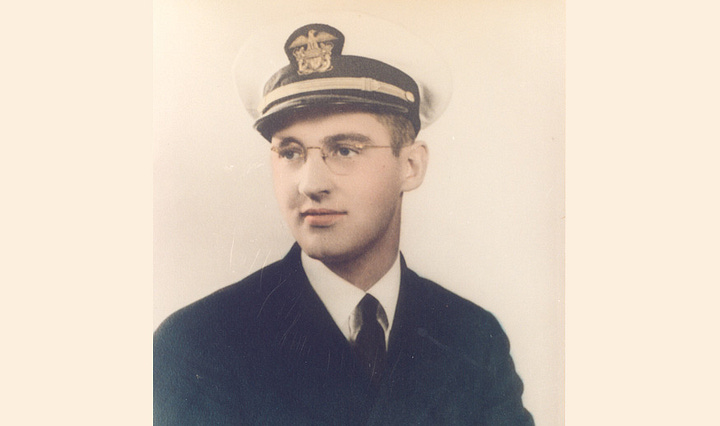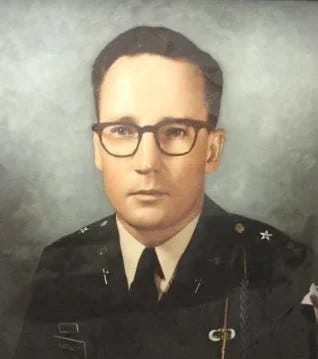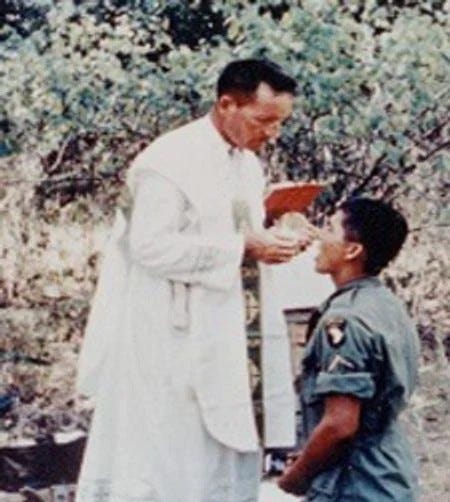Two Iowa chaplains among the first who gave it all in WWII and Vietnam
NE Iowa chaplains were at Pearl Harbor and with the Screaming Eagles in Vietnam


WATERLOO — On this Memorial Day, which falls in the same year we commemorate both the 80th anniversary of the end of World War II and the 50th anniversary of the end of the Vietnam War, it’s perhaps appropriate to remember the two Iowa military chaplains who were among the first to fall in each of those wars.
The first two U.S. military chaplains to be killed in action in World War II and the Vietnam War each were Roman Catholic priests from the Archdiocese of Dubuque in northeast Iowa — The Revs. Aloysius Schmitt and William Barragy, respectively.
Father Schmitt, of St. Lucas in Fayette County, a U.S. Navy lieutenant junior grade, was killed in the sinking of the USS Oklahoma at Pearl Harbor on Dec. 7, 1941.
He saved the lives of 12 sailors, helping them through a porthole before the ship capsized from aerial attack from torpedo bombers. He was one of 429 shipmates who perished, including many fellow Iowans. He had just finished celebrating morning Mass when the attack came.
He was posthumously awarded the Navy and Marine Corps Medal and the Silver Star, the nation’s third-highest military medal for valor, for “heroism involving voluntary risk of life.”

His Silver Star citation reads: “Chaplain Schmitt was aboard the USS Oklahoma when that vessel capsized and was entrapped in a compartment where only a small porthole provided outlet for escape. With unselfish disregard for his own plight, Chaplain Schmitt assisted his shipmates through the porthole. While his shipmates were in the process of rescuing him his body became wedged in the narrow opening.”
The citation continues, “Realizing that other men had come into the compartment looking for a way out, Chaplain Schmitt insisted that he be pushed back into the ship so that they might escape. Calmly urging them on with a pronouncement of his blessing, he remained behind while they crawled out to safety.”
His remains, along with those of many other USS Oklahoma sailors, were identified in 2016 by the U.S. Department of Defense POW-MIA accounting agency, using modern DNA technology.

St. Francis Xavier Chapel at Camp Lejeune, N.C. was dedicated in his memory and the Navy destroyer USS Schmitt was commissioned in his honor in 1943 and served through 1967.
He is interred at Christ The King Chapel at Loras College in Dubuque.
Willliam Joseph Barragy
U.S. Army Maj. Rev. William Joseph Barragy lived in Mason City during his youth and moved to Rockwell, then to Waterloo; his father was a doctor. He graduated from St. Mary’s High School in Waterloo before attending Loras College in Dubuque.
Barragy later became a Catholic priest after completing his studies at St. Mary’s Seminary in Baltimore. He served parish assignments at St. Raphael’s Cathedral in Dubuque from 1948 to 1950 and at St. Edward Catholic Church in Waterloo from 1950 to 1953, after which he joined the Army.


Maj. Barragy served in the Army for 12 years before his death, completing tours in Korea, Germany, and Okinawa.
In Vietnam, Father Barragy was attached to the U.S. Army 101st Airborne Division, known as “the Screaming Eagles” for their divisional patch, a storied unit which had distinguished itself in World War II. He did humanitarian work in Vietnam, serving troops as well as Vietnamese civilians, many of whom were Roman Catholic.
On May 4, 1966, he was flying into battle with 20 fresh troops who had just arrived “in country.” They were on a CH47 Chinook helicopter. According to eyewitness and investigators, the helicopter caught fire from an overheated combining transmission, lost power and crashed, 110 miles northwest of the South Vietnamese capital of Saigon. All 21 passengers were killed in the incident.
A memorial service was held for Father Barragy at St. Edward Catholic Church and he is buried at Calvary Cemetery in Waterloo.
I first heard about Fathers Schmitt and Barragy from one of my parish priests, the Rev. Paul Lippstock, when he was a chaplain for the Iowa Army National Guard. He served in the Sinai Peninsula and Iraq in the 2000s and attained the rank of lieutenant colonel in his 22 years with the Guard.
Some of the units he deployed with are going out again. A sendoff for the Waterloo-headquartered Iowa Guard 1st Battalion, 133rd Infantry Regiment, the “Ironman Battalion,” will be 6 p.m. Wednesday (May 28) at Cedar Falls High School. It will be the battalion’s fifth overseas deployment since 9-11. They will receive training in Louisiana prior to a year-long deployment to the Middle East along with 1,800 other Iowa Guard soldiers and 7,000 total from 21 states.
Prayers accepted.




I’m adding a note about a Kansas chaplain, not as an argument about the states, but as a further reflection on the heroism and sacrifice of chaplains. Emil Kapaun served in both WWII and the Korean wars. He died as a prisoner of war during the Korean conflict and is regarded as a martyr. He’s been denominated as a “Venerable,” a stage in the process toward sainthood.
Prayers for heroes.